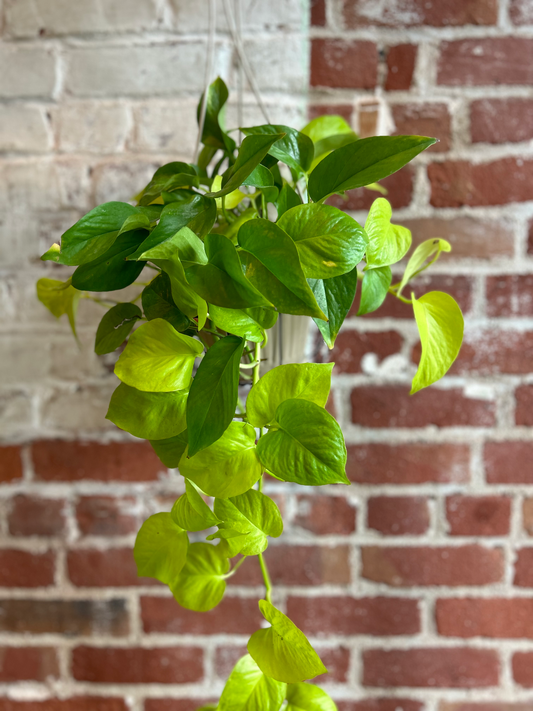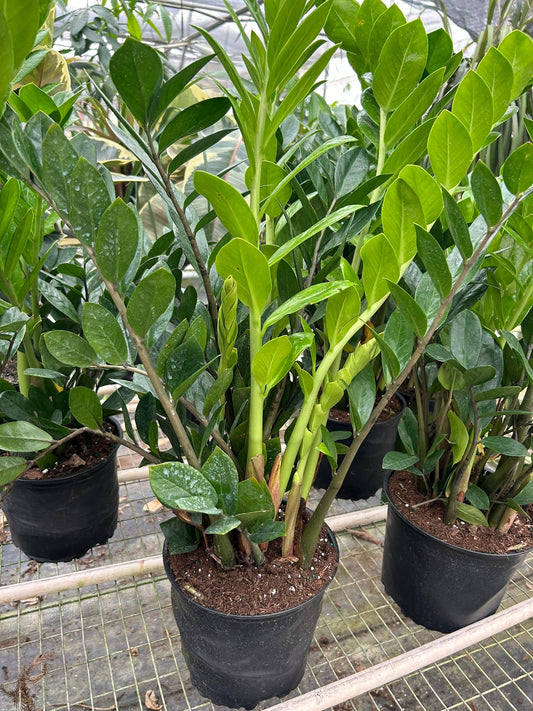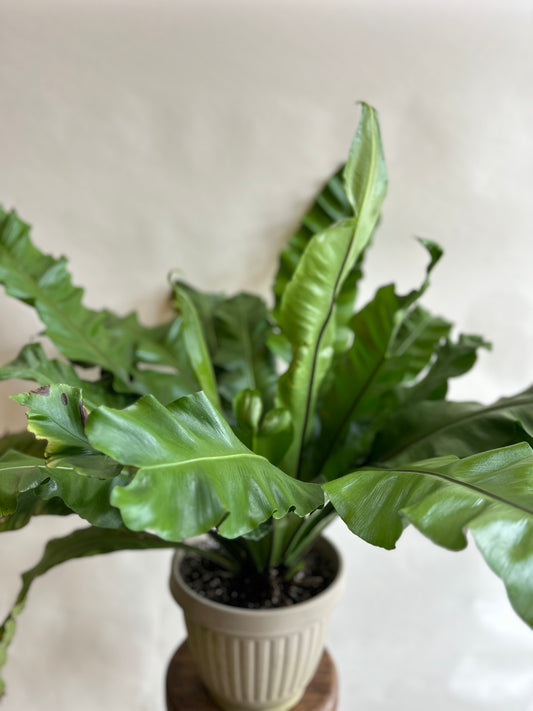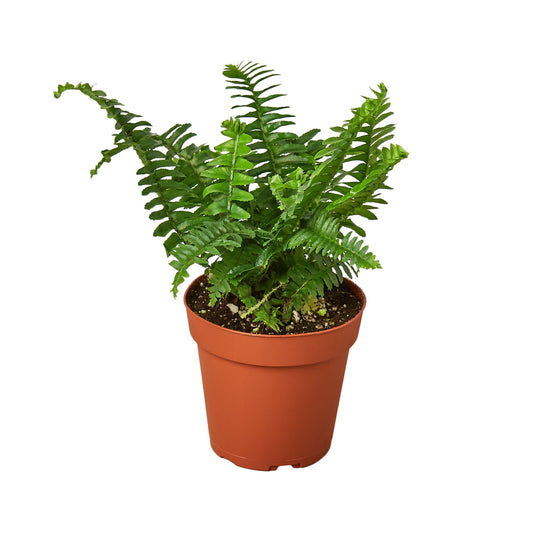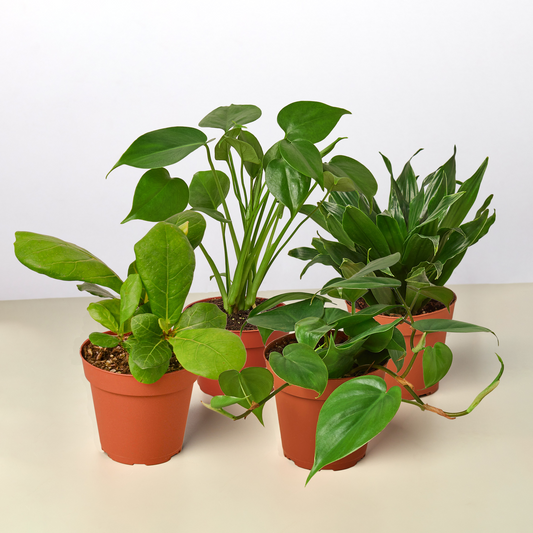Are Golden Pothos Toxic to Cats?
Cafe Planta Team
Golden Pothos, with its heart-shaped leaves and vibrant green and yellow hues, is a favorite among plant lovers for its easy care and adaptability. However, as much as we adore this trailing beauty, there's an important consideration for those of us sharing our homes with furry friends, especially cats.
In this article, we'll explore whether Golden Pothos is toxic to cats, what symptoms to watch for, and how to keep your feline companions safe while still enjoying the lush greenery of this popular houseplant. We'll also dive into some care tips for Pothos and alternatives that are pet-friendly, ensuring you can have a beautiful indoor garden without worry.
Understanding Golden Pothos: The Basics
Golden Pothos, scientifically known as Epipremnum aureum, is a tropical vine that's often heralded as the ultimate beginner's plant. It thrives in a variety of lighting conditions, requires minimal upkeep, and can be propagated with ease. No wonder it's often the go-to plant for adding a touch of nature to any space.
Besides its aesthetic appeal, Golden Pothos is also known for its air-purifying qualities. NASA's Clean Air Study listed it as one of the top plants for improving indoor air quality by removing toxins like formaldehyde and benzene. While this is great news for us humans, it doesn't necessarily translate to safety for our pets.
For cat owners, the question of toxicity is crucial. After all, our feline friends are notorious for exploring their surroundings with their mouths, often nibbling on anything that piques their curiosity. This brings us to the heart of the matter: are Golden Pothos dangerous for cats?
Golden Pothos and Cats: The Toxic Truth
Unfortunately, Golden Pothos is toxic to cats. The plant contains insoluble calcium oxalates, which are needle-like crystals that can cause irritation. When a cat chews on Pothos leaves, these crystals can penetrate their mouth tissue, causing discomfort and sometimes more severe symptoms.
Symptoms of Pothos poisoning in cats can include:
- Oral irritation
- Drooling
- Vomiting
- Difficulty swallowing
While these symptoms can be distressing, they're usually not life-threatening. However, it's always wise to consult with a veterinarian if you suspect your cat has ingested any part of a Golden Pothos. They can provide guidance on how to manage symptoms and ensure your pet recovers fully.
It's worth noting that, while cats might not be inclined to chew on plants regularly, some might do so out of boredom or curiosity. If your cat is one of these adventurous types, taking precautions to protect them from potentially harmful plants is essential.
Keeping Cats Safe from Toxic Plants
So, how can you enjoy your love for plants while keeping your feline friends out of harm's way? Here are some strategies to consider:
1. Placement is Key
One of the simplest solutions is placing your Golden Pothos in areas that are out of reach for your cats. High shelves or hanging baskets can be a great way to display your plants while keeping them safe from curious paws.
2. Use Deterrents
Cats are sensitive to certain smells. Citrus, for example, is a scent that many cats dislike. You can use citrus peels or a diluted citrus spray around the plant to deter your cat from approaching it.
3. Provide Alternatives
Sometimes, cats chew on plants because they're looking for something to nibble on. Offer your cat safe alternatives like cat grass or catnip plants. These can satisfy their chewing instincts without any risk.
4. Train and Supervise
While training a cat might seem like a tall order, it is possible to teach them boundaries with patience and consistency. Use positive reinforcement to reward them for avoiding the plants and supervise them when they're near your indoor garden.
Pothos Care Tips for Plant Lovers
Even though we have to be cautious with pets, Golden Pothos remains a fantastic plant for those of us looking to green up our living spaces. Here are some care tips to keep your Pothos thriving:
1. Light Requirements
Golden Pothos prefers bright, indirect light, but it's known for being highly adaptable. It can survive in low-light conditions, although its growth might slow, and the variegation on the leaves can fade. If you want to maintain its vibrant color, try to provide it with a good amount of indirect sunlight.
2. Watering Needs
One of the reasons Pothos is so beloved is its forgiving nature regarding watering. It's best to let the soil dry out between waterings. Overwatering is a common mistake, leading to root rot. A good rule of thumb is to water when the top inch of soil feels dry to the touch.
3. Soil and Potting
Pothos isn't fussy about soil but thrives in a well-draining potting mix. A standard houseplant or cactus mix works well. Ensure your pot has drainage holes to prevent waterlogging, which can damage the plant's roots.
4. Pruning and Propagation
Regular pruning helps keep your Pothos looking its best and encourages bushier growth. If your plant becomes leggy or overgrown, simply trim back the vines. You can propagate the cuttings in water or soil, giving you new plants to share or expand your collection.
Alternatives to Golden Pothos for Pet Owners
If you're concerned about the risks associated with having Golden Pothos around your cats, there are plenty of pet-friendly plants to consider. Here are a few that can offer the same beauty without the worry:
1. Spider Plant (Chlorophytum comosum)
Spider plants are not only non-toxic to pets, but they're also excellent air purifiers. They're easy to care for and have a charming, spiky appearance that can add character to any room.
2. Boston Fern (Nephrolepis exaltata)
This lush, green fern is safe for pets and is known for its air-purifying capabilities. It prefers higher humidity and indirect light, making it ideal for bathrooms or kitchens.
3. Peperomia (Peperomia spp.)
With a wide variety of leaf shapes and colors, Peperomias are a diverse group of plants that are safe for pets. They're low-maintenance and adaptable, fitting well into any home decor.
4. Areca Palm (Dypsis lutescens)
For those looking for a statement piece, the Areca Palm is a fantastic choice. It's non-toxic to cats and can bring a tropical vibe to your space without any risk to your pets.
By opting for these pet-friendly plants, you can still enjoy the benefits of an indoor garden while keeping your feline friends safe and sound.
Understanding Your Cat's Behavior Around Plants
Cats are naturally curious creatures, and their interactions with plants often stem from this curiosity. Understanding why your cat might be drawn to your houseplants can help you manage their behavior effectively.
1. Exploring and Playing
For some cats, plants are simply another object to explore and play with. They might bat at the leaves, dig in the soil, or even knock pots over. Providing plenty of toys and interactive playtime can help redirect this energy.
2. Chewing for Texture
Just like humans, cats can be attracted to certain textures. The sensation of chewing on leaves might be satisfying for them. Offering safe, alternative textures to chew on, like rubber toys or cat grass, can help satisfy this craving.
3. Nutritional Curiosity
Some cats might munch on plants if they're lacking certain nutrients in their diet. Ensuring your cat has a balanced diet with all the necessary nutrients can reduce this behavior.
Recognizing these behaviors and addressing them proactively can help minimize the risk of your cat interacting with toxic plants. It's all about understanding your feline friend and making adjustments to suit their needs.
Steps to Take If Your Cat Ingests Pothos
If you find yourself in the unfortunate situation where your cat has ingested Golden Pothos, it's essential to act quickly and calmly. Here's what you can do:
1. Identify the Plant
First, make sure you confirm that it is indeed Golden Pothos your cat has interacted with. This information is critical when consulting a veterinarian.
2. Observe Your Cat
Watch for any symptoms of distress or signs of poisoning, such as drooling, vomiting, or difficulty swallowing. Take note of these symptoms, as they can help the vet determine the best course of action.
3. Contact Your Veterinarian
Reach out to your vet as soon as possible for advice. They may recommend bringing your cat in for an examination or provide guidance on managing symptoms at home.
4. Prevent Future Incidents
After addressing the immediate situation, take steps to prevent it from happening again. This might mean moving your Pothos out of reach or replacing it with a non-toxic alternative.
Being prepared and informed can make a significant difference in how you handle such situations, ensuring your cat remains safe and healthy.
Integrating Plants into a Pet-Friendly Home
Creating a home that's both lush with greenery and safe for your pets is entirely possible with a bit of planning and consideration. Here are some tips to help you achieve this balance:
1. Research Before You Buy
Whenever you're considering a new plant, take the time to research its toxicity to pets. Many resources and databases can provide this information, helping you make informed decisions.
2. Designate Plant Zones
Create specific areas in your home dedicated to plants, where your pets have limited access. These can be shelves, windowsills, or hanging arrangements that keep the plants out of reach.
3. Combine Decor and Safety
Use decorative elements like terrariums or cloches to showcase plants while keeping them inaccessible to pets. These can add a unique aesthetic to your space while ensuring safety.
4. Stay Informed
Keep yourself updated on which plants are safe and which are not. Plant care and safety recommendations can change, so regular research can help you maintain a pet-friendly environment.
By thoughtfully integrating plants into your home, you can create a beautiful and nurturing space for both you and your pets.
Final Thoughts
Golden Pothos is a stunning addition to any home, but when living with cats, it's crucial to be aware of its potential risks. By understanding the symptoms of toxicity and taking preventative measures, you can keep your feline friends safe while still enjoying the beauty of your plants.
At Cafe Planta, we offer a variety of houseplants, including pet-friendly options, along with plant care accessories to help you create a luscious indoor garden. If you have any questions about plant care or need advice on choosing the right plants for your home, don't hesitate to reach out. You can email us or send a message on our Instagram. We're here to support you on your plant journey and help you build a joyful, green sanctuary that both you and your pets will love.


